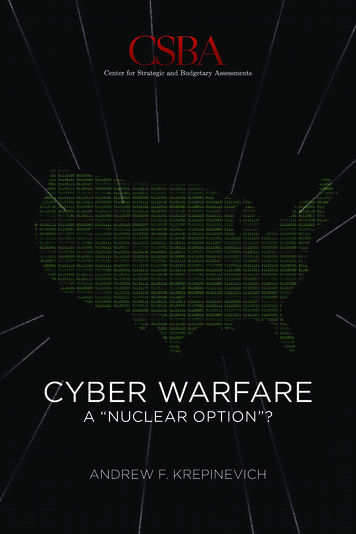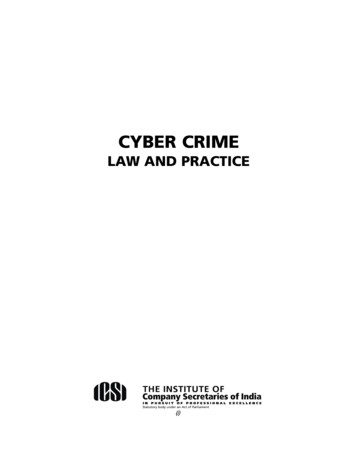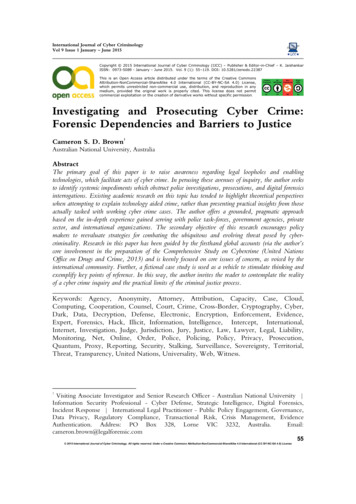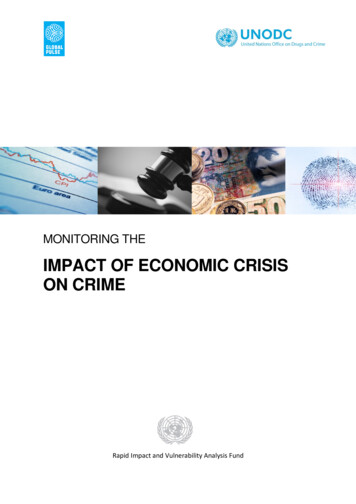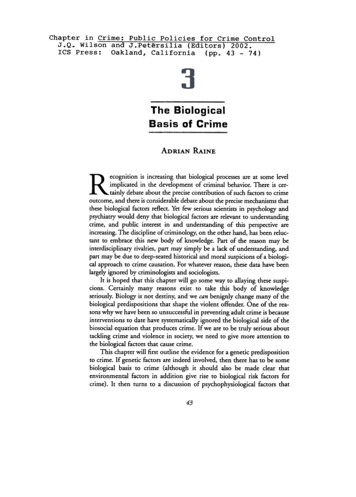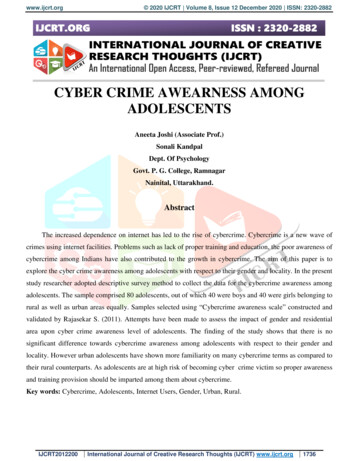
Transcription
www.ijcrt.org 2020 IJCRT Volume 8, Issue 12 December 2020 ISSN: 2320-2882CYBER CRIME AWEARNESS AMONGADOLESCENTSAneeta Joshi (Associate Prof.)Sonali KandpalDept. Of PsychologyGovt. P. G. College, RamnagarNainital, Uttarakhand.AbstractThe increased dependence on internet has led to the rise of cybercrime. Cybercrime is a new wave ofcrimes using internet facilities. Problems such as lack of proper training and education, the poor awareness ofcybercrime among Indians have also contributed to the growth in cybercrime. The aim of this paper is toexplore the cyber crime awareness among adolescents with respect to their gender and locality. In the presentstudy researcher adopted descriptive survey method to collect the data for the cybercrime awareness amongadolescents. The sample comprised 80 adolescents, out of which 40 were boys and 40 were girls belonging torural as well as urban areas equally. Samples selected using “Cybercrime awareness scale” constructed andvalidated by Rajasekar S. (2011). Attempts have been made to assess the impact of gender and residentialarea upon cyber crime awareness level of adolescents. The finding of the study shows that there is nosignificant difference towards cybercrime awareness among adolescents with respect to their gender andlocality. However urban adolescents have shown more familiarity on many cybercrime terms as compared totheir rural counterparts. As adolescents are at high risk of becoming cyber crime victim so proper awarenessand training provision should be imparted among them about cybercrime.Key words: Cybercrime, Adolescents, Internet Users, Gender, Urban, Rural.IJCRT2012200International Journal of Creative Research Thoughts (IJCRT) www.ijcrt.org1736
www.ijcrt.org 2020 IJCRT Volume 8, Issue 12 December 2020 ISSN: 2320-2882Introduction:Computers and the Internet have offered great benefits to society. More than one third of the world’stotal population, had access to the internet. The internet helps us in providing information as well as storingour data. It has become so crucial that it has become a vital part in people’s lives. Internet, though offersgreat benefit to society, however it can also present opportunities for crime, using new and highlysophisticated technology tools. The connected computer machines have created a different world calledCyber world or cyber space. It is a different world altogether, quite different from our real world. Due tospecial nature of this Cyberspace the cyber criminals get maximum opportunity to commit crime.Cybercrime is a new wave of crimes using internet facilities, which needs to be addressed urgently andearnestly by policy planners to protect the young generation as there is a high risk of becoming a victim ofthis crime (Mensch and Wilkie, 2011).Any crime that is done using computer and internet is known as cyber crime or computer crime. Dr.Debarati Halder and Dr. K Jaishankar (2011) defines cyber crimes as “Offences that are committed againstindividuals or groups of individuals with a criminal motive to intentionally harm the reputation of the victimor cause physical or mental harm, or loss, to the victim directly or indirectly, using moderntelecommunication networks such as Internet (Chat rooms, emails, notice boards and groups) and mobilephones (SMS/MMS)”. Cyber crime is done by the persons who are expert in computers and know thetechnique of hacking. The major cyber crimes reported, in India, are denial of services, defacement ofwebsites, SPAM, computer virus and worms, pornography, information theft, Trojan attacks, e-mailbombing, DOS attack, hacking someone’s system, downloading illegal files. Virus, a small program that issent to different computers using internet, may harm the other systems is also a form of cyber crime.Relevance of the study:Cyber crime is emerging as a serious threat in the World. Governments as well as police andintelligence departments have started educating the people to deal with it. Indian police has initiated specialcyber cells across the country. Hence it is very important that students, particularly adolescents should haveawareness about the cyber crime. So there is a need to study the cyber awareness of the students who arebeing groomed to be the future nation.Review of related studies:Many researchers have tried to study the cyber crime awareness structure of adolescent girls and boys ofrural and urban areas. Firdous Ahmad (2019) has found significant difference between male and femaleadolescents on their level of cybercrime awareness. Male adolescents were observed with high level ofcybercrime awareness as compared to female adolescents. Suvera and Tailor (2020) have found significantdifference between Cyber-crime Awareness of male and female students. There is significant differencebetween Cyber-crime Awareness of rural and urban students. Swamy Deepa (2018) has found teenagersIJCRT2012200International Journal of Creative Research Thoughts (IJCRT) www.ijcrt.org1737
www.ijcrt.org 2020 IJCRT Volume 8, Issue 12 December 2020 ISSN: 2320-2882using internet has less knowledge about cyber crime. Even they are doing some type of cyber crime withoutknowledge.Jazeel (2018) has found significant difference between Cyber-crime Awareness of male and femalestudents and significant difference between Cyber-crime Awareness of rural and urban students. In theresearch cyber crime awareness level of girls has found to be higher than boys and the cyber crime awarenesslevel of urban have found to be higher than rural students. Moanes, Kholod and Bashier (2019) has foundsignificant difference between Cyber-crime Awareness of science, computer science and language subjectstudents. In this research cyber crime awareness level of science students was found to be higher thancomputer science and language students.Spring Neetu (2018) has found significant difference between cyber crime awareness of male and femalestudents. In the study cyber crime awareness level of male was found higher than the female students.Kumaravelu (2018) has found significant difference between Cyber-crime Awareness of male and femalestudents and significant difference between Cyber-crime Awareness of rural and urban students. In the studycyber crime awareness level of boys was found to be higher than girls and the cyber crime awareness level ofurban was found to be higher than rural students. Kumar Rajender (2020) has found significant differencebetween Cyber-crime Awareness of male and female students and significant difference between Cybercrime Awareness of rural and urban students. Male and urban students have more digital wrongdoingmindfulness than female and rural students.On the basis of the reviewed literature it was concluded that the awareness about cyber crime need tobe explored with a focus on the role of gender and residing locality of the adolescent.Objects: Following objects have been framed for the study To find out the impact of gender upon cyber crime awareness of adolescent boys and girls. To find out the impact of locality upon cyber crime awareness of Rural and Urban adolescents.Hypothesis: Following hypotheses have been framed for the study There will be no significant impact of gender upon cyber crime awareness of adolescent boys andgirls. There will be no significant impact of locality upon cyber crime awareness of Rural and Urbanadolescents.METHOD:Sample:The total sample comprised of 80 adolescents. Who have been selected with the help of randomizedsampling technique from various villages and cities of kumaun area of Uttarakhand. Out of 80 adolescences40 were boys (20 rural and 20 urban) and 40 adolescences were girls (20 rural and 20 urban). The age rangeof the sample was between 14 to 19 years of age.IJCRT2012200International Journal of Creative Research Thoughts (IJCRT) www.ijcrt.org1738
www.ijcrt.org 2020 IJCRT Volume 8, Issue 12 December 2020 ISSN: 2320-2882Tools used:For the collection of data “Cybercrime awareness scale” constructed and validated by Rajasekar S.(2011) has been used. It is an individually administering scale for cyber crime awareness. The inventory hasa total 36 items. 21 are positive and 15 are negative items. Each statement have five options, namely“Strongly Agree”, “Agree”, “Undecided”, “Disagree”, “Strongly Disagree”. The responses of the subjectswere scored by assigning numerical values or arbitrary weights to the two set of items as the statementsshowing positive and the statements showing negative. The positive statements having the scoring as 5, 4, 3,2 and 1 and for the responses from “strongly agree” to “strongly disagree” and it has been reversed for thenegative statements i.e., 1, 2, 3, 4 and 5 for the responses “strongly agree” to “strongly disagree”. Also thereare 21 positive statements and the statements are 1, 2, 4, 6, 7, 9, 11, 12, 14, 17, 18, 20, 21, 23, 24, 26, 27, 29,30, 34 and 36. Also there are 15 negative statements and the statements are 3, 5, 8, 10, 13, 15, 16, 19, 22, 25,28, 31, 32, 33 and 35. The score ranges from 36 to 180. The construct validity of the scale was found to be0.87 and reliability was determined by using the Spearman-Brown prophecy formula, was found to be 0.76.Techniques of data collection:In the study interview and questionnaire were used for the testing of proposed hypothesis. Each subjectwas treated individually. Consent was also taken from the respondents after explaining to them the purposeof the research as well as the academic use of the data later on. Before administering the tests a short intakeinterview was taken where their doubts related to the tests were dealt with. Scoring was done as per given inthe manual. After the data collection Mean and t-test had been calculated to test the significance of Mean ofthe two groups.Results:Findings have been summarized in the table-1. Table shows the Mean and t scores of cyber crimeawareness of girls and boys adolescences and rural and urban adolescences. A close perusal of the tableshows that the impact of gender was found non-significant (t 0.77, N.S.). However boys (M 141.8) haveshown more cyber crime awareness than girls (M 138.5). The table shows that the impact of area was foundnon-significant (t 1.64, N.S.). However urban (M 143.55) have shown more cyber crime awareness thanrural adolescents (M 136.75).IJCRT2012200International Journal of Creative Research Thoughts (IJCRT) www.ijcrt.org1739
www.ijcrt.org 2020 IJCRT Volume 8, Issue 12 December 2020 ISSN: 2320-2882Table: 1– Level of Cyber Crime Awareness of adolescences:Cyber Crime rls40138.5Rural40136.75Urban40143.55t- valueSignificantLevel0.77NS1.64NSCyber Crime ysGirlsRuralUrbanDISCUSSION:In this study attempts have been made to access the level of cyber crime among adolescent boys andgirls. The impact of residing area of the adolescent upon cyber crime awareness level has also been tried tomeasure.Our first hypothesis that ‘there will be no significant impact of gender upon cyber crime awareness ofadolescent boys and girls’ was substantiated. Although the mean score of boys was higher than girls, whichshows a little bit higher level of cyber crime awareness in boys than girls. But this difference was notsignificant enough to accept the gender impact upon cyber crime awareness. It may be because theaccessibility to internet is equally available for girls as well as boys. Similar results were obtained by GoelUrmila (2014) in her study. She found awareness towards cybercrime is not significantly affected by genderbut it is affected by area of residence and stream of study.IJCRT2012200International Journal of Creative Research Thoughts (IJCRT) www.ijcrt.org1740
www.ijcrt.org 2020 IJCRT Volume 8, Issue 12 December 2020 ISSN: 2320-2882Jagvinder Singh’s (2012) studied about cyber crime awareness among XII students in Bathinda,Punjab. He found that the gender of the students did not create a difference in the level of awareness ofcybercrime. The stream chosen by the students also did not play a part in the awareness level. Same resultshave been noted by Singh Jagdish (2013). He found gender and stream does not play a significant role oncyber crime awareness of XII class students. So, in the study the gender was not found significant affecter ofcyber crime awareness level.Our second hypothesis that ‘there will be no significant impact of locality upon cyber crime awarenessof Rural and Urban adolescents’ stands as true. The mean score of urban adolescents is higher than that ofthe rural adolescents. It shows that urban adolescents have shown a little bit higher level of cyber crimeawareness, but this difference was not found significant. Similar results were found by Shekhar Chandra andSamriti (2018). They found no significant difference between Cyber-crime Awareness of girls and boysstudents and found no significant difference between Cyber-crime Awareness of rural and urban students.The finding was also supported by Singaravelu & Pillai (2014), who found B.Ed. students has lowlevel of cybercrime, Moreover male B.Ed. graduates found better than female in cyber crime awareness butthere is no significant difference between B.Ed. students residing areas, computer facility, participated incyber forums in awareness on cyber crime. Sukanya & Raju (2017) conducted to know the Cyber LawAwareness among Youth of Malappuram District have a basic level of understanding on informationTechnology Act, 2000 in India and found vast minority (41%) undergraduates from rural area are totallyunfamiliar with IT Act, 2000. Gender, education and area of living do not show any significant relationshipin understanding the cyber law awareness of IT Act, 2000 in India. So, in the study the locality of residenceas rural or urban did not found to affect cyber crime awareness level of adolescents.On the basis of the above findings it can be concluded that gender and residing area have not affectedthe level of cyber crime awareness of the adolescents. The awareness level can be enhanced through theaccess toward new technology.IJCRT2012200International Journal of Creative Research Thoughts (IJCRT) www.ijcrt.org1741
www.ijcrt.org 2020 IJCRT Volume 8, Issue 12 December 2020 ISSN: 2320-2882REFERENCESAnisha (2017) Awareness and strategy to prevent Cybercrimes: An Indian perspective. Indian journal ofapplied research. Volume - 7 Issue - 4 April-2017 ISSN - 2249-555X IF : 4.894. PP. 114-116Firdous Ahmad (2019) CYBERCRIME AWARENESS AMONG ADOLESCENTS IN DISTRICTKUPWARA OF NORTH KASHMIR. Journal Current Science. ISSN: 9726 - 001X, Impact Factor:5.97 Vol. 20, No 06Goel, Urmila (2014) “Awareness among B.Ed. teacher training towards cyber-crime- A study, LearningCommunity”, Vol. 5 (2), August 2014, pp. 107-117.Halder, D., & Jaishankar, K. (2011) Cyber crime and the Victimization of Women: Laws,Rights, andRegulations. Hershey, PA, USA: IGI Global. ISBN 978-1-60960-830-9Jazeel (2018) A Study on Awareness of Cybercrime among Teacher Trainees in Addalaichenai GovernmentTeachers College. Journal of Social Welfare and Management. Volume -10. issue 1, PP. 31-34.Kumaravelu (2018) Awareness of cyber crime among B.Ed. teacher trainees in puducherry region. Researchreflection on education. ISSN: 0974-648X. Volume- 17. Issue 3 January –March.Kumar Rajender (2020) A Study of Cyber Crime Awareness Among B.Ed. And M.Ed. Students of SirsaDistrict. International Economic Society. Volume 11, Issue 3, PP. 74-86.Mensch, S. and L. Wilkie, (2011). Information security activities of college youn graduates: Anexploratory study. Acad. Inform. Manage. Sci. J., 14: 91-116.Moanes, Kholod and Bashier (2019) Cyber crime Awareness among Students at a Teacher Training College.International Journal of Computer Trends and Technology (IJCTT). ISSN: 2231-2803. Volume 67Issue 6. PP. 11-17.Shekhar Chandra and Samriti (2018) Cybercrime Awareness among B.Ed. Teacher Trainees. PeriodicResearch. ISSN No. 2231-0045 VOL.-7, ISSUE-1, August-2018 E: ISSN No. 2349-9435 P.P 65-68.Singaravelu & Pillai. (2014). B.Ed. student’s awareness on cybercrime in Perambalur district. InternationalJournal of Teacher Educational Research. ISSN : 1308 - 951X Vol. 3 Issue-3. PP. 37-40.Singh Jagdish (2013) To analyze cyber crime awareness of class XII students. Scholarly Research JournalFor Interdisciplinary Studies. ISSN- 2278-8808 JULY- AUGUST 2013, Vol. – I, Issue-I P.P. 13261330.Spring Neetu (2018) A survey of B.Ed. students’ perception and awareness towards cybercrime. Journal ofEmerging Technologies and Innovative Research (JETIR) ISSN-2349-5162, Volume 5, Issue 9. PP.406-417Sukanya, K. P.& Raju, C. V.( 2017). Cyber Law Awareness among Youth of Malappuram District. IOSRJournal of Humanities and Social Science, 22( 4), Ver. 5 ,23-30.IJCRT2012200International Journal of Creative Research Thoughts (IJCRT) www.ijcrt.org1742
www.ijcrt.org 2020 IJCRT Volume 8, Issue 12 December 2020 ISSN: 2320-2882Suvera and Tailor (2020) Cyber-crime awareness: a comparative study of male and female B.Ed. trainees.The International Journal of Indian Psychology. ISSN 2348-5396 (e) ISSN: 2349-3429 (p)Volume 8, Issue 1,P.P. 361-365.Swamy Deepa (2018) AWARENESS OF CYBER CRIME AMONG TEENAGERS. International Journalof Recent Scientific Research. ISSN: 0976-3031 Vol. 9, Issue, 5(I), pp. 27073-27075,IJCRT2012200International Journal of Creative Research Thoughts (IJCRT) www.ijcrt.org1743
cyber crime awareness level of boys was found to be higher than girls and the cyber crime awareness level of urban was found to be higher than rural students. Kumar Rajender (2020) has found significant difference . After the data collection Mean and t-test had been calculated to test the significance of Mean of the two groups. Results:


